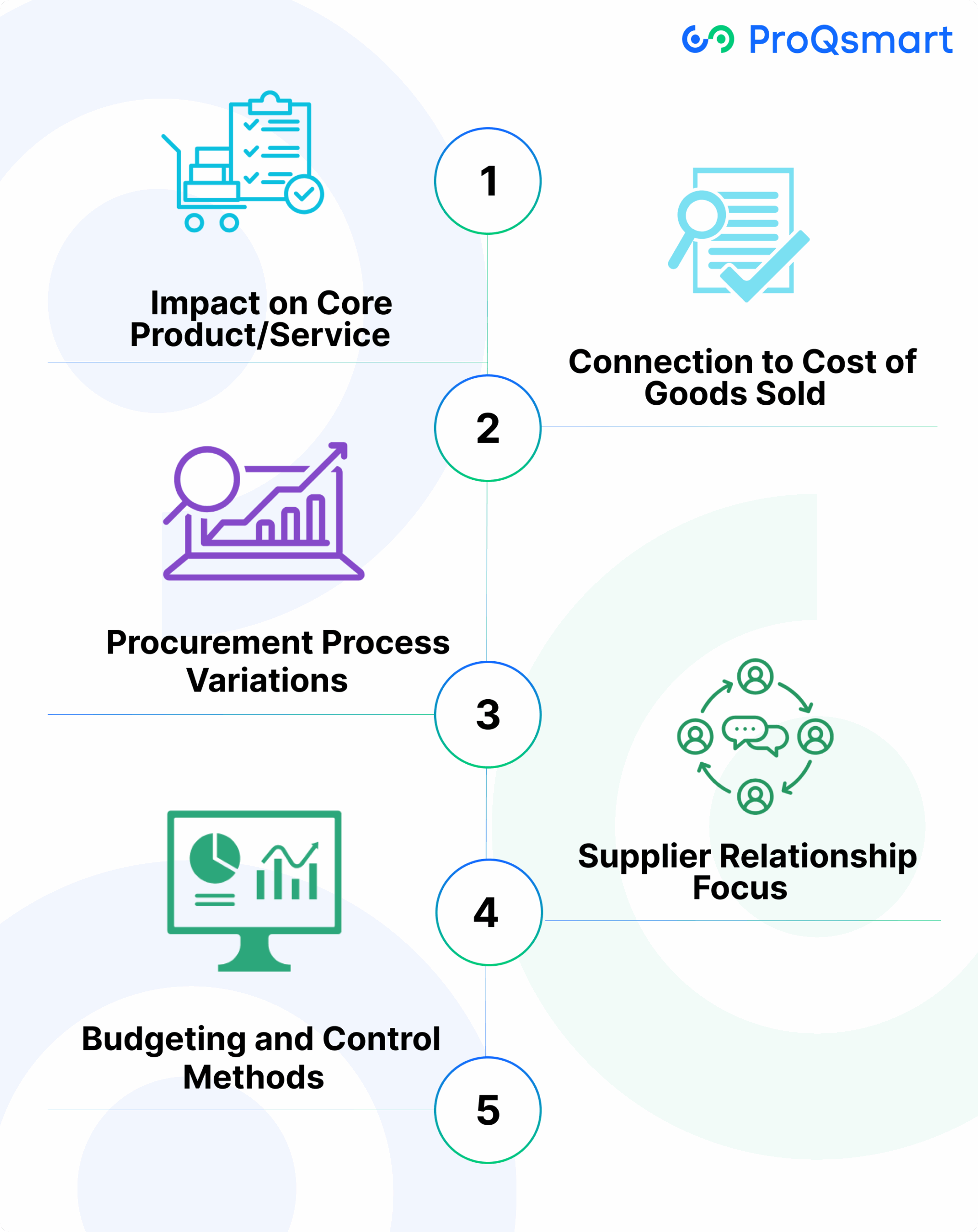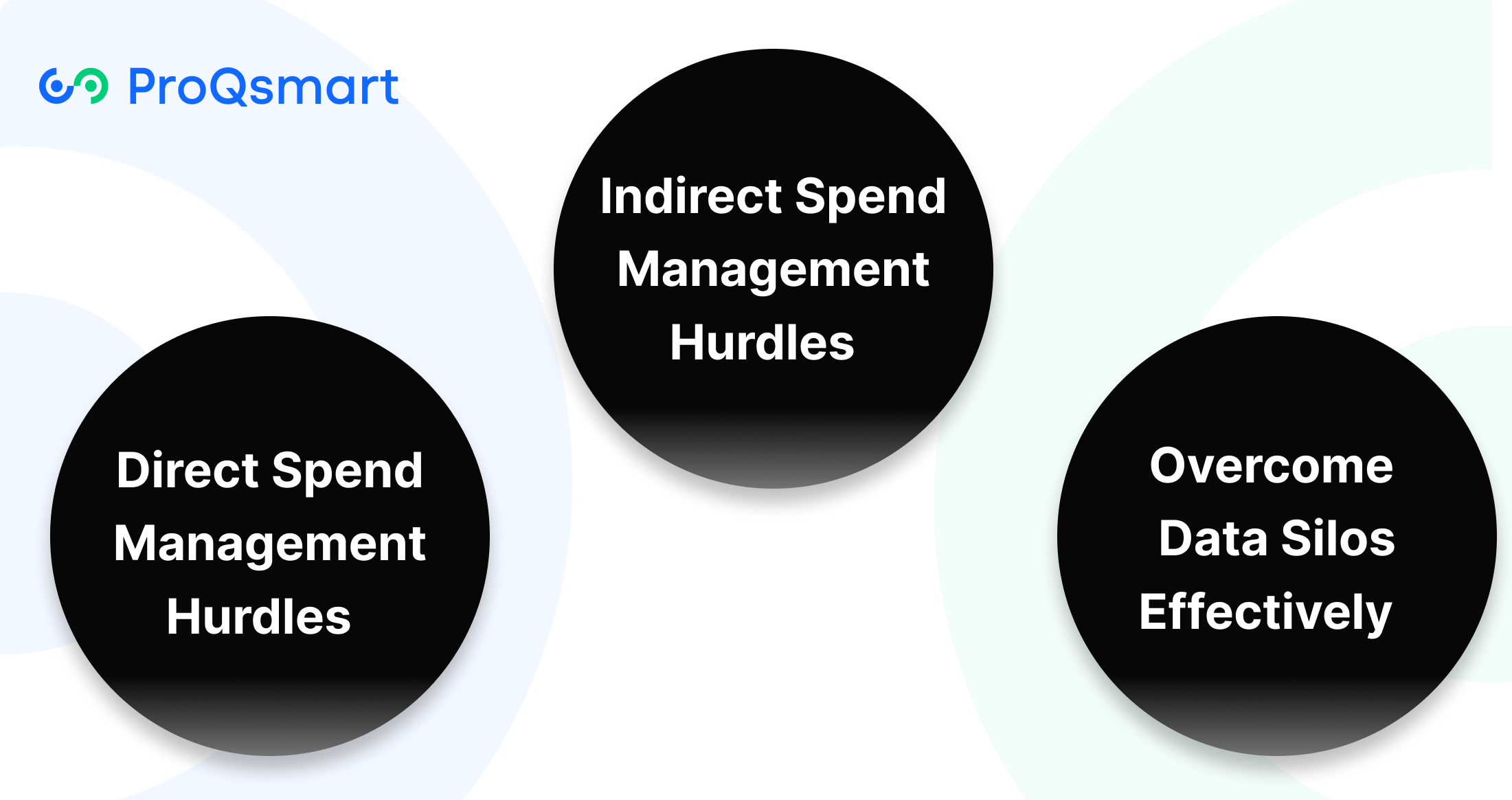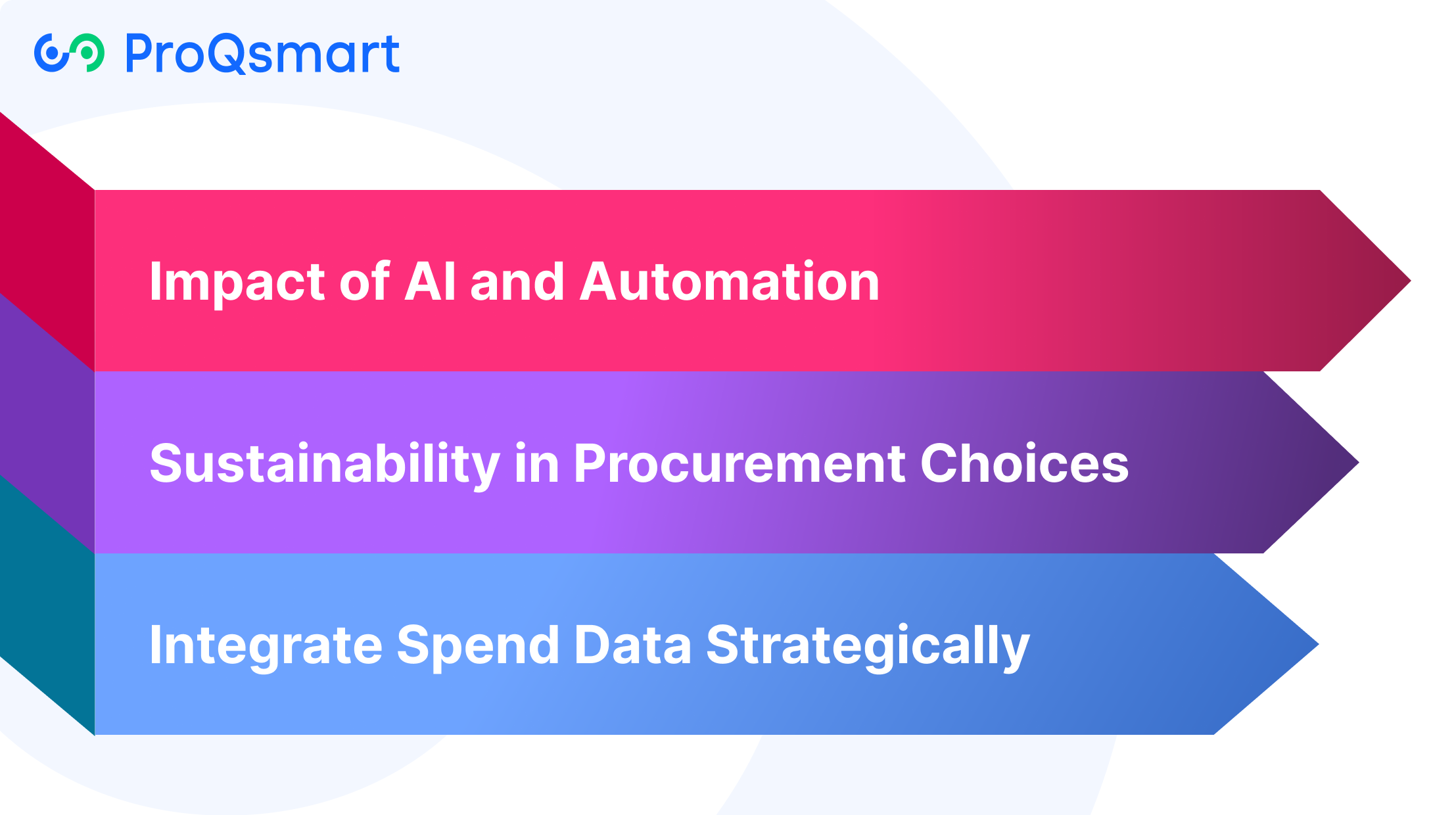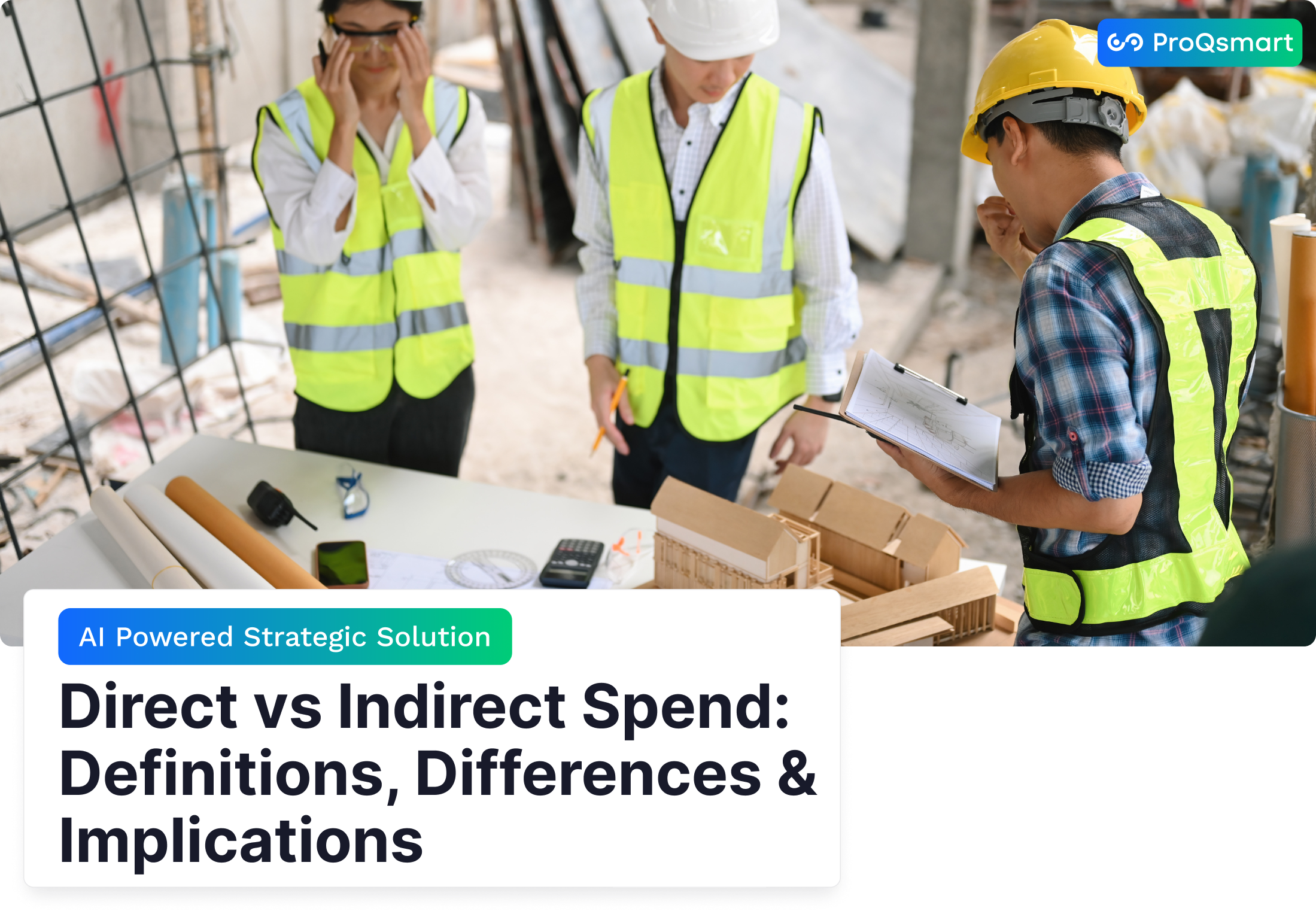Indirect spend is spending not directly tied to what a company produces or sells. This includes all direct costs such as raw materials, components, and capital equipment used in manufacturing.
Indirect spend usually encompasses expenses that keep the business running. This category includes stuff like office supplies, utilities, and maintenance services, none of which go into our final product.
Understanding the differences between direct and indirect spend helps businesses allocate budgets more effectively. It also enhances supplier relationships and maintains compliance with financial goals.
What Is Direct Spend?
Direct spend refers to the procurement of goods and services that are directly tied to the production of a product or service. Developing the final output is largely dependent on these expenses. They typically include direct spend on things like materials, labor, and other costs directly related to the production of goods.
To illustrate direct procurement strategies, businesses may directly impact spend by buying steel for automotive components. Alternatively, they might procure chemicals for use in drug manufacturing or even outsource precision machining services. These purchases have a direct impact on the quality, functionality, and availability of the final deliverable.
What are the categories of direct spend? These usually include direct materials, direct labor, and direct overhead costs. Direct materials spend is what most people picture when they think about direct spend. Labor costs cover the wages of workers involved in production, while overhead costs might involve equipment maintenance or energy used during manufacturing.
Managing these expenses in the world today is imperative, especially considering that 52% of purchase order lines experience changes in delivery dates or quantities! Leveraging systems such as Enterprise Resource Planning (ERP) aids in achieving this by forecasting demand and allowing for timely procurement solutions needed to continue production.
The importance of direct spend goes beyond what they are producing. It is extremely important to budgeting and financial planning, as these costs directly impact profit margins. Without a good handle on direct procurement needs, unwanted supply chain hiccups can occur, delaying production schedules and diminishing customer satisfaction.
The opposite is true, as good management produces predictable quality, cost, and efficiency, generating value that allows the company to achieve higher level business goals.
What Is Indirect Spend?
Indirect spend procurement is defined as all procurement activities that are not directly associated with producing a good or service. In contrast, direct spend procurement focuses on raw materials and components essential for the production process.
Indirect procurement encompasses costs associated with sustaining day-to-day operations and increasing internal efficiency. Though often overlooked, this category comprises a huge array of important purchases. From office supplies and employee wages to marketing campaigns and SaaS tools, it runs the gamut.
Typical examples of indirect procurement categories include office supplies, catering, and products used to provide electric and gas utilities, and can even include travel expenses. These costs, although not directly tied to producing a good or service, are essential to supporting operational efficiency, which in turn fuels employee productivity.
Investing in ergonomic office furniture not only improves workplace comfort but also enhances employee productivity. Although this doesn’t immediately impact your direct procurement needs, the product improvements ultimately affect overall business profitability.
Effectively managing this area is critical to optimizing overall business performance. Without deliberate plans, these indirect procurement costs are often allowed to balloon, straining budgets and harming bottom lines.
Take SaaS subscriptions or marketing campaigns—both require longer-term planning to ensure the value you’re purchasing aligns with your organization’s goals. Unique indirect procurement challenges are ingrained within indirect spend due to its nature of supporting many departments with diverse functions.
Direct vs Indirect Spend: Key Differences

Understanding the differences between direct and indirect spend procurement is essential for strong procurement operations. Both are undeniably important, but their nature, trajectory, and effects are starkly different.
1. Impact on Core Product/Service
Direct spend is important when guaranteeing quality goods. Most importantly, it directly affects the production of many critical raw materials and intermediate components that go into finished products.
Consider the example of bad-quality steel used in automotive manufacturing. That steel suddenly breaks the production line.
Indirect spend, although not tied to production, affects service delivery and workplace efficiency. Costs such as office supplies or employee benefits, though indirect, influence how business operations are maintained and overall employee satisfaction.
While mismanaging direct spend risks delays and compromised quality, managing indirect spend correctly unlocks the full potential of service delivery.
2. Connection to Cost of Goods Sold
Direct spend directly impacts the Cost of Goods Sold (COGS), thus impacting profitability. For instance, they help manage the impact of volatile material prices on production costs.
Indirect spend indirectly affects operational expenses, such as maintenance which will indirectly affect COGS. Monitoring both types of spend helps guarantee accurate fiscal accounting and management of expenses.
3. Procurement Process Variations
Direct procurement relies heavily on ERP systems to analyze demand and automate order processes, providing a level of forecastable predictability.
Indirect procurement typically has a greater dependence on manual processes and lacks the strong predictability that allows for strategic planning. Custom workflows maximize productivity and effectiveness for each work type.
4. Supplier Relationship Focus
Direct spend places a higher value on supplier collaboration to achieve favorable terms, quality, and reliability. The opportunity to make real-time adjustments to orders—now the case in over half (52%) of POs—underscores this need.
Indirect spend is less about keeping transactional relationships going and much more about the overall management of cost.
5. Budgeting and Control Methods
Having distinct budgets for direct and indirect spend allows for more strategic control. Direct spend directly connects to revenue generation, whereas indirect spend connects more with operational efficiency.
This means they need different strategies for controlling costs.
Why Indirect Spend Matters More
Indirect spend procurement has emerged as a newfound focus area in today’s business landscape. Unlike direct procurement tied to core production, indirect procurement encompasses costs like IT, marketing, HR, utilities, and travel. These areas are essential for daily operations and can significantly impact overall procurement costs.
Shockingly, indirect spending could be responsible for as much as 70% of total company spend, but it tends to fly under the radar. Its complexity requires customized management strategies, as it spans a wide range of indirect procurement categories and suppliers. When the procurement teams have effective oversight, there are quantifiable benefits.
It fuels crucial cost savings and enhances operational agility, making it more critical than ever in our hyper-competitive reality.
Uncover Hidden Operational Costs
Poor management of indirect spend often hides inefficiencies, such as redundant contracts, maverick spending outside preferred suppliers, or inadequate supplier performance. Audit and data analytics on a continual basis can expose buried wastage.
They can frequently disclose these duplicitous and frequently hidden categories such as office supplies and consulting fees. For instance, over half (52%) of purchase order lines have their delivery date or quantity changed. This speaks to the urgent need for continuous, real-time collaboration with suppliers.
Platforms such as ProQsmart increase visibility even further by automating workflows and tracking supplier performance. They make sure compliance is built in, defeating hidden costs before they bloom.
Boost Overall Business Efficiency
Optimizing indirect spend helps procurements run more smoothly, lessening the administrative burden and speeding up workflows. This efficiency multiplies their productivity, allowing them to redeploy resources to more strategic initiatives.
Take, for example, budget-driven tracking tools in ProQsmart, which help connect procurement activity with fiscal targets towards fostering smart, effective operations. When indirect spend is integrated with core business processes, employee morale is positively affected by more efficient workflows and increased availability of resources.
Find Significant Savings Opportunities
A strategic data analysis can spotlight significant cost-saving opportunities in an organization’s energy use or shipping fees, or a number of other categories. ProQsmart’s AI-driven analyticsenables you to source more intelligently and negotiate better conditions with your suppliers.
Whether it’s automating subcontractor management or e-tenders, businesses can remove wasted costs, powering huge savings.
Gain Strategic Value Beyond Costs
Optimizing indirect spend aligns procurement with broader business objectives. By supporting continual, real-time supplier collaboration, ProQsmart empowers companies to build stronger supplier relationships and supplier-driven innovation.
Effective indirect spend management goes beyond minimizing costs. It enables more sustainable, strategic growth over the long term.
Unique Challenges in Spend Management

Unique challenges exist in managing the spend, particularly in both direct and indirect procurement. Direct spend involves materials critical to production, while indirect spend relates to non-production goods and services.
From user-facing products to research and development efforts, each category comes with distinctive challenges that require careful consideration and innovative approaches to maximize cost effectiveness and operational effectiveness.
Direct Spend Management Hurdles
Supplier relationships in direct procurement are critical to maintaining quality and delivery consistency. Keeping these connections entails a commitment to transparency, regular communication, and equitable management of contracts.
For example, a manufacturer reliant on precision components must work closely with suppliers to prevent delays or defects, which can disrupt production.
Inventory management is an additional challenge. Maintaining proper stock levels while avoiding overstocking or stockouts requires accurate forecasting and coordination with production schedules.
Having too much raw material stocked over-commits capital, and a stockout could mean stopping production completely.
Volatile raw material pricing adds another layer of complexity to this already difficult procurement task. Businesses need to closely track market conditions and strategically negotiate contracts that protect them from the perils of price fluctuations.
Strong risk management practices are key to managing through any supply chain disruption or sudden supplier challenge.
Indirect Spend Management Hurdles
Indirect spend management is typically faced with siloed processes and no visibility. This decentralized purchasing creates mixed levels of adherence to organizational procurement policies, thereby creating maverick spending.
Such out-of-compliance behaviors as employees doing end runs around approved channels for one-off purchases can inadvertently inflate costs and result in missed savings opportunities.
This is further complicated when trying to negotiate favorable terms with indirect suppliers, as needs are often spread across multiple departments.
Implementing a platform such as ProQsmart consolidates all procurement information into one platform, automates compliance verification and better tracks supplier performance. This directly counters these challenges.
Overcome Data Silos Effectively
Breaking down data silos and understanding the big picture is key to making informed decisions.
This centralized data integration garners cross-departmental collaboration, better progress tracking, and greater strategic procurement as a whole organization, delivering better results organization-wide.
Optimize Both Direct and Indirect Spend
Recognizing the complexity and differences within direct and indirect spend is critical to developing successful procurement strategies. Direct spend is defined as all raw materials and components critical to the production process.
In contrast, indirect spend includes necessary operational costs, like office supplies and services. A holistic approach guarantees these two areas are optimized together, fueling efficiency and cost savings across the board.
Personalized tactics, tech synergies, and an interconnected workforce help realize this equilibrium.
Tailor Your Procurement Strategy
It’s critical that procurement strategies match the distinct natures of both direct and indirect spend. When it comes to direct spend, a focus on supplier reliability and inventory optimization avoids expensive production delays.
A flexible approach is the need to be flexible — the markets are changing constantly and require quick pivots. Indirect spend, however, is better served by such practices as zero-based budgeting, making sure that expenditures match up with organizational priorities.
Utilizing data-driven insights, procurement decisions can be guided by up-to-the-minute trends, allowing for the intelligent allocation of resources.
Leverage Technology and Data Tools
That’s why modern procurement technology, including innovative platforms like ProQsmart, increases efficiency and drives value throughout both direct and indirect corporate spend.
Whether it is creating e-tenders or managing supplier relationships, ProQsmart’s AI-driven tools make this easy while guaranteeing compliance with auditable data.
Enhanced workflows through real-time tracking of supplier performance and automated workflows help streamline processes for both direct and indirect spend.
For indirect spend, e-procurement systems streamline inefficiencies and for direct spend, integrated ERP systems alert teams when production materials need to be replenished.
Foster Internal Team Collaboration
Collaboration between indirect and direct procurement/operations teams leads to better spend management. Bringing together cross-functional teams helps align procurement goals with the overall business objectives, providing energy and synergy across departments.
Open communication improves outcomes, particularly when real-time supplier collaboration addresses changes in delivery schedules—an issue affecting 52% of purchase order lines.
Implement Smart Category Management
Category management, a concept that focuses procurement strategies to specific areas of spend, aims to address this. For instance, market research helps agencies make informed decisions, ensuring suppliers provide competitive pricing and increasing the efficiency of the supplier community.
Good management leads to fewer stockouts and lower carrying costs which translates directly to improved operational performance.
Enhance Supplier Relationships Proactively
As with any successful initiative, strong supplier relationships are critical for optimizing direct spend. Ongoing performance reviews based on real-time data help ensure that all suppliers are consistently fulfilling contract terms.
Open lines of communication foster goodwill and transparency. ProQsmart’s supplier relationship tools enable seamless collaboration, driving long-term value.
Measure Spend Management Success
In spend management, success is more than saving money. It’s about generating quantifiable value. Measure the success of both direct and indirect spend with specific metrics. Ensure spend management success by aligning your procurement practices with your organization’s broader objectives.
Without a crystal-clear view into where and how money is being spent, creating action plans is impossible. Measuring success by focusing on key performance indicators (KPIs) helps you make sure every dollar spent adds to operational efficiency and value creation.
Essential Direct Spend KPIs
Direct spend KPIs focus on spend that goes into creating products. This of course includes supply spend such as raw materials and consumables which can make up 50% of non-labor spend. Metrics, such as cost savings realized through initiatives like Todd Turner’s direct negotiations in commoditized areas, underscore the efficiency of procurement.
Supplier performance, as determined by delivery schedules, product quality, and dependability of supply, dictates an uninterrupted flow to the production line. Healthy inventory turnover rates tell the story of a healthy supply chain, cluing organizations in on whether their inventory levels are right-sized or bloated.
Routine monitoring of these KPIs is key to spotting where attention is needed and keeping procurement efficient and cost-effective.
Essential Indirect Spend KPIs
Indirect spend, historically perceived as the black box, is anything that isn’t a production-related cost such as office supplies or janitorial services. Monitoring compliance rates helps you stay on track with your business procurement policies and guidelines instead of rogue spending, we mean.
Spend visibility and visibility into who is spending what, while increasingly consolidating this data, gives organizations firmer control over spend. Things like reduced cost, which we can realize through complex discounting well beyond the usual 10%, push us to significant savings.
Establishing a regular process to review and act upon these KPIs sits at the heart of achieving sustained indirect cost management success.
Holistic Spend Visibility Metrics
Integrated spend transparency with direct and indirect categories is key. Additional metrics like category-wise spend analysis and supplier consolidation reveal risks Turner says are often concealed without transparency.
Platforms such as ProQsmart give organizations the boost they need with AI-powered reporting to harmonize and simplify decision-making and cross-team collaboration. Through automated workflows and compliance checks, ProQsmart™ allows for 360-degree visibility, so that every procurement decision can be made with your organization’s priorities front and center.
Future Trends in Spend Management

Spend management is undergoing a massive transformation, particularly in indirect procurement. Technological acceleration, sustainability requirements, and the need for agile procurement strategies have all contributed to this evolution. To stay ahead, organizations must adopt forward-looking procurement solutions that maximize the efficiency of their direct and indirect spend, driving sustainable long-term value.
Impact of AI and Automation
AI and automation are transforming the procurement landscape, particularly in indirect procurement, by removing tedious, manual tasks that consume so much time with efficient, automated processes. Automating RFIs, RFPs, purchase orders, and invoice processing not only saves a huge amount of money but also speeds up the process significantly.
AI’s capacity to process extensive data sets reveals actionable insights, enhancing supplier relationship management, cost negotiation, and demand forecasting. Platforms such as ProQsmart bring these capabilities together, offering solutions like e-tendering and real-time tracking to ensure procurement decisions align with budgets. By leveraging AI-driven automation, procurement teams can promote operational efficiencies and strengthen supplier connectivity, creating a solid competitive edge.
Overall, the integration of AI in procurement not only addresses indirect procurement challenges but also enhances the overall procurement processes. This evolution supports procurement teams in making data-driven decisions that lead to cost reduction and improved vendor performance evaluations, ultimately driving better business outcomes.
Sustainability in Procurement Choices
Sustainability considerations are increasingly becoming a core part of procurement decision-making. Member organizations deepen their commitment to sustainability by sourcing sustainable materials and promoting energy-efficient manufacturing.
They rationalize their suppliers to reduce environmental footprints. These strategies yield significant cost savings and brand reputation benefits in addition to helping corporations achieve their sustainability goals.
As an illustration, sustainable procurement minimizes waste and enhances inventory management through better tracking of material use and accurate demand forecasting. Aligning with sustainability is a surefire way to ensure businesses are meeting their environmental and financial objectives—all in one smooth motion.
Integrate Spend Data Strategically
Strategic integration of spend data across jurisdictions is key for informed, equitable, and strategic decision-making. For example, advanced analytics can help you identify trends, optimize supplier performance, and allow you to negotiate with more power.
ProQsmart shines here, providing critical functionality to screen suppliers, track subcontractors, and help with capital expenditure tracking and reporting. An integrated data strategy promotes transparency, compliance, and collaboration enterprise-wide to ensure procurement goals are met on time and under budget.
Conclusion
Corporate finance and procurement strategies around managing direct and indirect spend dramatically #BuildOurFuture determine how businesses scale, innovate, and compete globally. Direct spend is what keeps our productions rolling, but indirect spend is what props up operations behind the scenes. Striking a balance between the two unlocks significant savings potential, improves overall efficiency, and builds stronger supplier relationships. Effective spend management requires strong strategies, ongoing monitoring, and effective tools. It’s no longer just about saving money. It’s about making more strategic decisions and being agile in a rapidly evolving environment.
The next era of spend management is going to be powered by technology and data. AI and advanced analytics empower companies to take meaningful steps toward forecasting future trends, identifying savings opportunities, and making data-driven strategic plans. Adopting these tools today creates resilience and opportunity for the future.
Looking to go further and faster with Indirect Spend? Discover the power of ProQsmart and schedule a demo today!




